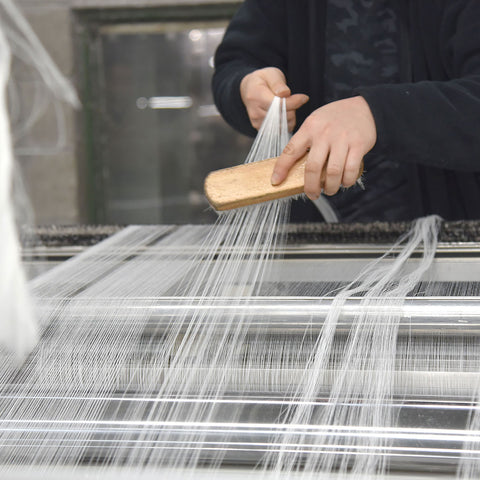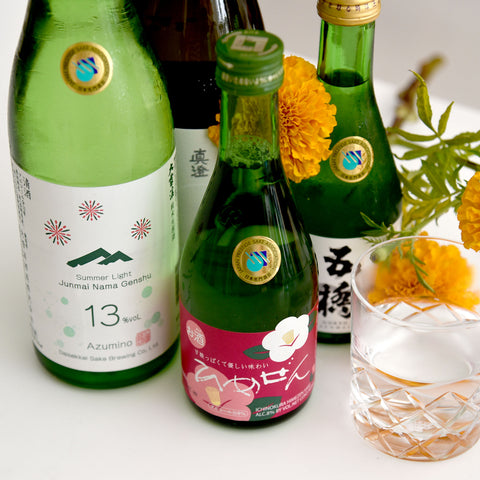 Sake Gumi is our monthly sake subscription service with 200 members throughout the country. Join today!
Sake Gumi is our monthly sake subscription service with 200 members throughout the country. Join today!
I am going out on a bit of a limb here, introducing umeshu for Sake Gumi, but Umami Mart has always been about breaking boundaries. And based on the rising interest in our umeshu-making kit and hugely popular housemade umeshu we serve at the bar, I’m hoping that members will find the drink as interesting and refreshingly delicious as I do. In fact, I find that umeshu is a drink that’s enjoyed across the board – from wine and sake drinkers to whisky connoisseurs, it seems to be a flavor profile that many people find pleasing and nostalgic. It’s both sweet and tart with a distinct aroma of dried fruit. It’s also one of the most satisfying summer drinks when served on-the-rocks or with a splash of soda – perfect for August.
Umeshu is composed of two words, ume (often referred to as Japanese plum, but it is arguably closer to an apricot) and shu (the Japanese word for alcohol). Umeshu is often translated as “plum wine,” which is a bit of a misnomer since it’s not fermented – it is a maceration of ume and sugar in alcohol. Although most commonly soaked in shochu, umeshu can also be made with sake, whisky, and vodka. Since we are introducing umeshu in the context of Sake Gumi, I have chosen umeshus with a sake base. Each member this month will get an umeshu and a sake from the same brewer so you can compare their regular sake with their umeshu sake.
The first mention of umeshu was documented in 1695 in the Japanese culinary bible Honcho-shokkan. It’s unclear if the objective was to preserve the plums or end up with the liqueur that resulted from the process. Whatever the initial intention, it has evolved to become a drink that almost every household in Japan makes. Each family seems to have a different recipe consisting of three ingredients: ume, sugar, and alcohol, with varying techniques involving ume preparation (to remove the heta stem or not to?) and how long the umeshu infuses.
Commercially produced umeshu has proved to be very popular in Japan. Consequently, umeshus with additives (artificial color, and added vitamin C) started to appear on the shelves. To differentiate these with additive-free umeshu, the category of honkaku umeshu (authentic umeshu) was established.
I’ve chosen two honkaku umeshu for Sake Gumi this month, and both are unique for different reasons. Level 1 members will get Nanbu Bijin No Sugar Umeshu that has no added sugar and uses a zen koji sake which tastes a bit like mirin to make up for the lack of added sugar. Level 2 members will get the Saika Nigori Umeshu, which incorporates the pulp of premium Kishu ume to create a nigori (cloudy) umeshu.
I hope that you will enjoy going out on an ume tree limb with me this month. In addition to being a very fun summer category, I feel like it’s appropriate to discuss this very traditional Japanese drink with an interesting history.
Kanpai,
Yoko (Co-Founder + Sake Director at Umami Mart)

Nanbu Bijin No Sugar Umeshu
Nanbu Bijin (Iwate, Japan)
Seimaibuai: Toyonishiki 65%, SMV: -50, Acidity: 3.0
Nanbu Bijin’s umeshu adds no sugar and instead uses their All Koji Sake (a full-bodied sake with concentrated sweetness and umami made only with koji rice) to balance the tartness of the ume. Macerated with koji sake and ume for only two weeks, this clear, light pink umeshu is bright, light, tart, and clean – think fresh cranberries and pomegranates. One of my favorite things about this umeshu is that it proves that you don’t have to infuse ume for very long to take advantage of the fruit’s merits. A quick maceration highlights the fresh and light astringency of the ume skins. Kosuke Kuji, the 5th generation brewer of Nanbu Bijin adds, “We use plums from the plum grove around Shoboji Temple in Oshu City, Iwate Prefecture.” Try this elegant umeshu chilled in a wine glass with bolder flavors including al pastor tacos, chicken wings, and gindara misoyaki.

Nanbu Bijin Tokubetsu Junmai
Nanbu Bijin (Iwate, Japan)
Seimaibuai: Gin Otome 55%, SMV: +5, Acidity: 1.6
A great midsummer sake, this tokubetsu (special) junmai uses local Iwate sake rice Gin Otome milled down to 55% and wafts aromas of juicy white peach, green apple, and cherry blossom. I love the light texture that tastes as vividly of white peach as it smells without being cloying. Kuji enjoys having this sake chilled with seafood carpaccio or stir-fried tofu.
 Workers removing stems from each ume at Nanbu Bijin.
Workers removing stems from each ume at Nanbu Bijin.

Saika Nigori Umeshu
Kokonoe Saika (Wakayama, Japan)
Seimaibuai: N/A, SMV: N/A, Acidity: N/A
At first glance, you may mistake this sake for a natty orange wine with sediment, but swirl it around and you’ll see ume pulp clinging to the sides of the glass, and then notice an intoxicating bouquet of dried apricot and figs. The texture is thick and chewy, but it’s surprisingly not as sweet as you may think. The tartness of this umeshu is reminiscent of INNA Jam’s Quince Shrub – one of my favorite shrubs.
President Toshimitsu Saga says, “the plums soaked in sake are pulled out after three months, strained, and finally blended back into the sake-based umeshu.” A hearty profile allows you to pair this sake on-the-rocks with heavier dishes such as BBQ ribs and kung pao chicken. Or, as Saga suggests, “pour it over ice cream!”

Saika Yamahai Junmai
Kokonoe Saika (Wakayama, Japan)
Seimaibuai: 65% Gohyakumangoku, SMV: +4, Acidity: 1.9
This yamahai junmai has a gorgeous light-golden hue which seems to hint at its aromas of dried apricot, dulce de leche, and banana. Enjoy hints of crème fraîche and savory dried fruit notes. Saga suggests having this sake at room temperature with flavorful fish such as tuna, salmon, and yellowtail. When asked about the label, he said “It is a three-legged crow called yatagarasu, and it is said to be the messenger of guidance.”
 Production Manager Tatsuya Miyamoto at Kokonoe Saika.
Production Manager Tatsuya Miyamoto at Kokonoe Saika.




Comments (0)
There are no comments for this article. Be the first one to leave a message!